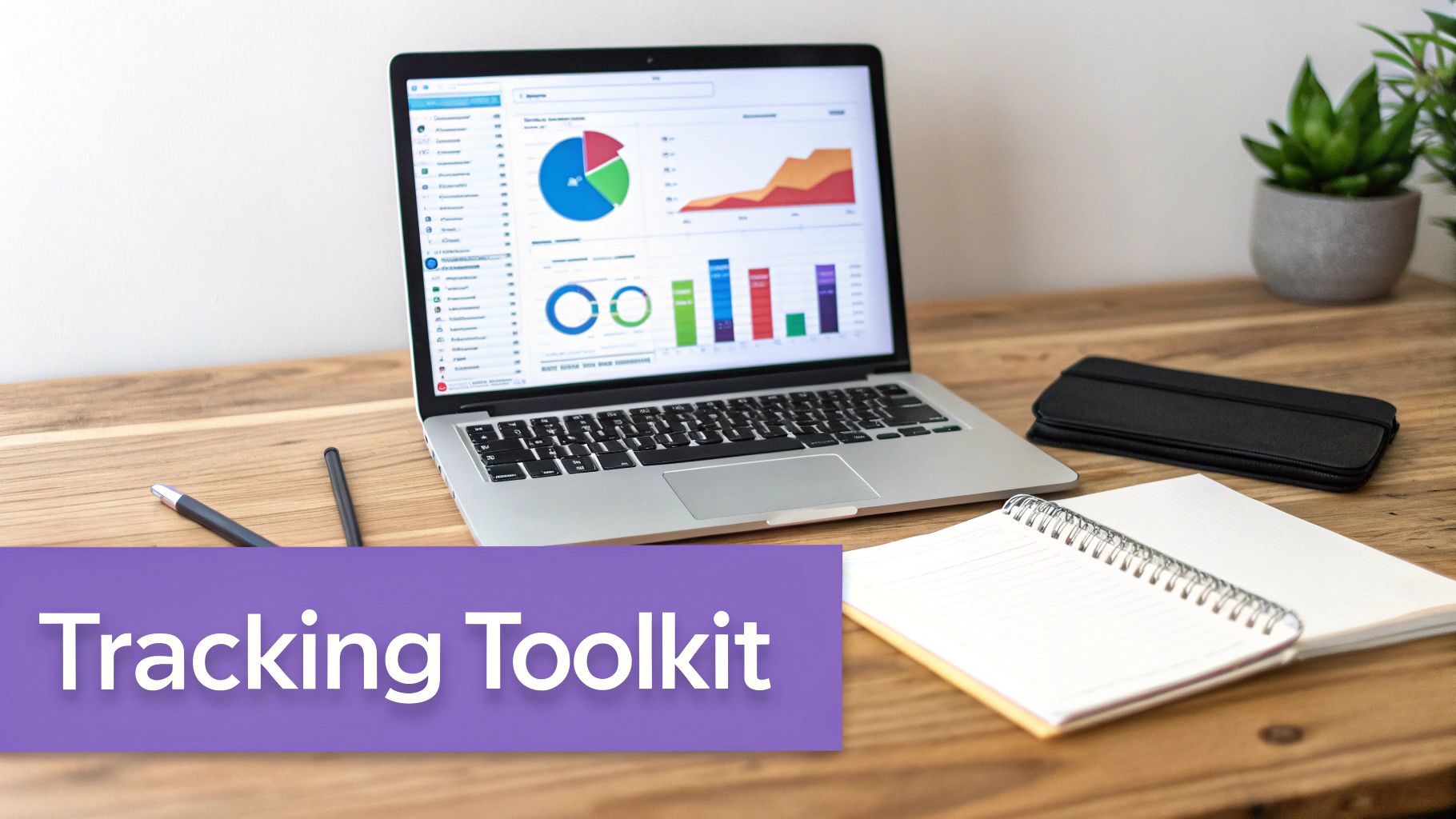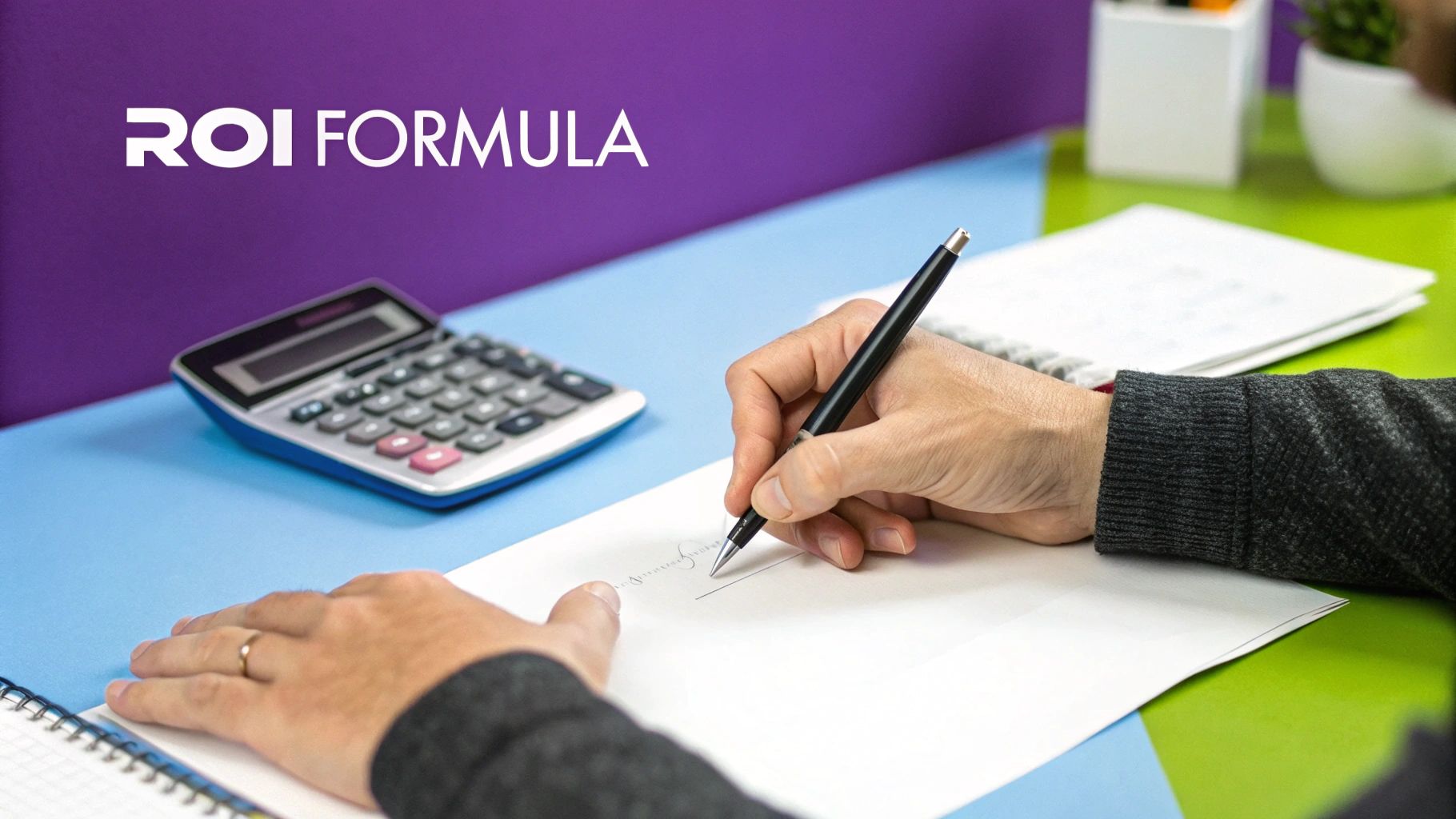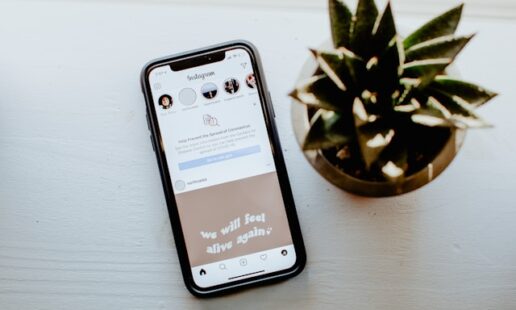How to Measure Social Media ROI on Instagram

Let’s get one thing straight: vanity metrics like follower counts don’t pay the bills. Chasing a big number might give you a temporary ego boost, but it’s a hollow victory if it doesn’t actually grow your business. This is where understanding how to measure your social media ROI becomes a total game-changer.
The core idea is simple. You need to draw a straight line from your creative work on Instagram directly to things that matter-revenue, leads, and real brand growth. It’s about shifting from looking at surface-level stats to asking the tough questions. Did that Reel series actually sell products? Did that influencer collaboration drive newsletter sign-ups? This is the kind of strategic thinking that separates professional creators from hobbyists.
The Problem with Vanity Metrics
Focusing only on followers and likes is like judging a restaurant by its flashy sign instead of the food. A huge follower count looks impressive, but it says absolutely nothing about the health of your business. It’s why so many creators are tempted to buy Instagram followers to inflate these numbers, but trust me, this is a critical mistake for your ROI.
Why is it so bad? Because those purchased followers are almost always bots or completely disengaged accounts. They will never:
- Buy your products or services.
- Become loyal advocates for your brand.
- Give you meaningful feedback or engagement.
- Click on your affiliate links.
Even worse, they completely contaminate your analytics, making it impossible to understand who your real audience is or measure what’s actually working. A smaller, highly engaged community is infinitely more valuable than a massive, silent one.
The ultimate goal isn’t just to be seen-it’s to be effective. Measuring your return on investment forces you to focus on activities that don’t just capture attention but drive action.
Making the Shift to Business Outcomes
This whole process boils down to a few key steps: set clear goals, track what you’re spending (time and money), and then do the math to see if you’re actually making a profit.
This visual just reinforces the basic idea that you have to know your destination (your goals) before you can map out the journey and count the costs. This shift from superficial metrics to business-focused ones is happening everywhere. In fact, a recent industry analysis showed that 77% of marketers say proving ROI is more important to their bosses than ever, pushing them to obsess over KPIs like conversion rates and customer acquisition costs.
Adopting this data-driven approach is non-negotiable for serious creators. Once you understand which posts and campaigns are generating real value, you can stop wasting time on what doesn’t work and double down on what does. You can get a much better handle on your native analytics with our complete guide on Instagram Insights. This mindset is your blueprint for turning creative passion into a profitable, sustainable business.
Define What Success Actually Looks Like for You

Before we even touch a single number, we need to answer a simple but crucial question: what does success actually look like for you?
Jumping straight into your analytics without a clear goal is like setting out on a road trip with no destination. You’ll burn a lot of fuel, but you won’t end up anywhere meaningful. Your goals are the bedrock of your entire ROI calculation. They give your metrics context and purpose. Without them, numbers are just numbers.
Connecting Your Efforts to Business Goals
I see this all the time-a huge disconnect between what creators do on social media and what their business actually needs. The 2025 Sprout Social Index™ hit the nail on the head: 65% of leaders want to see a direct line from social campaigns to business results, but only 30% of marketers feel they can actually prove it.
This gap exists because people get caught chasing metrics that don’t tie back to the bottom line. To fix this, every single thing you do on Instagram has to be connected to a bigger business objective. Ditch vague goals like “increase engagement.” Let’s get specific.
- Vague Goal: “I want to grow my account.”
- ROI-Focused Goal: “I want to generate 20 qualified leads for my coaching program each month through Instagram DMs and link clicks.”
See the difference? This simple shift in thinking changes everything. Suddenly, you’re not just posting content; you’re building a system designed to produce a specific, valuable outcome.
Tailoring Goals to Your Unique Creator Business
Your definition of success is going to be unique. A food blogger’s goals will look completely different from a fitness coach’s or an e-commerce brand’s. Don’t get caught up in what other creators are doing. Focus on what moves the needle for your business.
Let’s look at a few real-world scenarios:
For the Course Creator: Your main goal is probably selling seats in your online course. Success means tracking link clicks to your sales page, webinar sign-ups from your Stories, and, ultimately, the number of course purchases that came from Instagram.
For the Affiliate Marketer: It’s all about driving sales through your unique affiliate links. Your key metrics are click-through rates on product links, the conversion rate on the merchant’s site, and the total commission you’ve earned.
For the Service Provider: If you’re a freelance designer or consultant, your goal is lead generation. You’d measure success by the number of discovery calls booked, inquiry forms filled out, or direct messages from potential clients.
The key is to work backward. Start with the ultimate business result you want-more sales, more clients, more subscribers-and then figure out the specific Instagram actions that will get you there.
Why You Can’t Ignore Your Engagement Rate
While direct sales and leads are the ultimate prize, don’t write off your engagement rate. Think of it as the engine that powers all your other goals. An engaged audience is far more likely to trust your recommendations, click your links, and eventually become customers. Trying to hit sales targets with a dead audience is next to impossible.
This is also why you should never buy Instagram followers. Fake followers absolutely wreck your engagement rate, making your account look spammy to both real users and the algorithm. This directly torpedoes your ability to achieve any real business objective.
If you’re wondering what a good benchmark looks like, it’s worth taking the time to learn more about how to calculate and improve your engagement rate on Instagram. It’s a foundational metric for proving long-term ROI.
Build Your ROI Tracking Toolkit
Once you’ve figured out what success looks like, it’s time to assemble the right gear. Measuring your Instagram ROI isn’t about juggling a dozen complicated platforms. It’s about building a simple, effective system that gives you the data you need without the headache.
You actually have some pretty powerful tools at your fingertips already.
If you have an Instagram Business account, you’re sitting on a goldmine of free data. Instagram Insights is your first stop for understanding how your content performs, who your audience is, and when they’re most active. It’s the perfect native tool for tracking those foundational metrics like reach, engagement, and follower growth, right from your phone.
Here’s a peek at the kind of professional dashboard available directly within the Instagram app.
This dashboard gives you a quick, high-level overview of your account’s performance, which is always the starting point for any real ROI analysis.
Beyond the Basics With Advanced Tools
While native analytics are great for a quick look, they definitely have their limits. To truly understand your ROI, you often need a more unified view, especially if you’re active on other platforms or want to see how trends develop over the long haul.
Third-party analytics platforms can pull all your data into a single dashboard, saving you a ton of time and revealing deeper connections between your efforts and your results. For anyone serious about growth, exploring the best Instagram analytics tools can unlock more robust features for competitor analysis and automated reporting, painting a much clearer picture of your performance.
Essential Tracking Tools for Instagram Creators
Picking the right tools can feel overwhelming. To help you get started, here’s a quick comparison of free and paid options that can help you track the metrics that really matter for proving your ROI.
| Tool/Method | Best For | Cost | Key Feature for ROI |
|---|---|---|---|
| Instagram Insights | Quick, on-the-go performance checks. | Free | Post-level engagement and reach data. |
| Google Analytics | Tracking website traffic from Instagram. | Free | Identifying which posts drive the most clicks and conversions. |
| UTM Builders | Pinpointing traffic from specific campaigns/links. | Free | Granular tracking for bio links, Story swipes, and ads. |
| Hexrate | All-in-one social media tool. | Paid | Comprehensive reporting across channels in one dashboard. |
| Hootsuite | Teams managing multiple social accounts. | Paid | Advanced scheduling and unified analytics. |
Ultimately, a good toolkit is one you will actually use. Start with free tools to see what data matters most, then think about a paid tool when you need to scale up your reporting.
Let’s Talk About Buying Followers (And Why It’s a Terrible Idea)
We need to address the elephant in the room: the temptation to buy Instagram followers. From a purely ROI-focused perspective, this is one of the worst things you can possibly do. It might give you a temporary ego boost, but it permanently wrecks your ability to measure what actually works.
When you buy followers, you’re paying to break your own analytics. Your data gets flooded with ghosts, making it impossible to tell what your real audience is doing.
Imagine trying to figure out which of your products is a bestseller when 90% of your “followers” are fake accounts. You can’t. Your engagement rate will tank, your reach will get crushed as the algorithm flags your account, and any ROI calculation you try to make will be based on completely meaningless numbers.
Real ROI comes from real people, not an inflated follower count. Period.
Tracking Conversions Like a Pro
The real magic in measuring ROI happens when you can connect an Instagram post directly to a sale or a new lead. Here is how to set up tracking techniques that are easier than you think.
UTM Parameters: These are just little snippets of text you add to a URL. Think of them as tracking codes that tell your analytics (like Google Analytics) exactly where a website visitor came from. You can create unique UTM links for your bio, Stories, and ad campaigns to see which ones are actually driving traffic and sales.
Instagram Shopping: If you sell physical products, here is how to get started: set up Instagram Shopping. It lets you tag products right in your posts and Stories, creating a super smooth path from discovery to purchase. This gives you a direct, easily measurable revenue stream from your content.
Affiliate and Discount Codes: For influencers or brands running promotions, unique codes are your best friend. How to use them is simple: assign a specific code (like “CREATOR15“) to a campaign or creator. This lets you track every single sale that originated from that specific effort. It’s clean, simple, and incredibly effective.
By building a toolkit with these elements-native insights, specialized analytics, and conversion tracking methods-you create a system that sees past surface-level metrics. You’ll have a clear, data-backed view of which activities are actually moving the needle, which is the whole point of this exercise.
How to Calculate Your ROI With a Simple Formula

Alright, let’s get down to the numbers. Don’t worry, you won’t need a degree in accounting for this. The formula for social media ROI is actually pretty straightforward, and once you get the hang of it, you can apply it to pretty much any campaign you run on Instagram.
Here’s the basic formula:
(Profit – Investment) / Investment * 100 = ROI %
It’s that simple. A positive percentage means you made money, and a negative one means you lost it. The real magic isn’t in the math itself-it’s in accurately defining what “Profit” and “Investment” actually mean for your brand.
Defining Your Total Investment
Your investment is way more than just what you spend on ads. To get a true, honest picture of your return, you have to account for every single resource you pour into your Instagram strategy. This is where so many creators and brands mess up, leading to an inflated ROI that doesn’t reflect reality.
Here’s how to track your investment:
- Ad Spend: The obvious one. This is any money you spent boosting posts, running Story ads, or any other paid promotion.
- Tools and Software: Don’t forget those monthly subscriptions for scheduling tools, analytics platforms, or design apps like Canva. They add up.
- Content Creation Costs: Did you hire a photographer? Buy props for a Reel? Purchase stock photos or video clips? These are all direct costs.
- Your Time: This is the big one people forget. Your time is valuable. You need to assign yourself an hourly rate-even a conservative one-and track the hours you sink into a campaign.
Tracking your time is a non-negotiable for an accurate ROI. Think about it: if a campaign generated $200 in profit but took you 15 hours to pull off, was it truly a win?
Assigning a Value to Your Profit
Next up is the “Profit” side of the equation. If you’re tracking direct sales, this is easy-it’s the revenue you brought in. But what about goals that aren’t so clear-cut, like generating leads or growing your email list?
You have to assign a monetary value to those actions.
To properly measure your social media ROI, you have to translate every goal into a dollar amount. This forces you to connect your creative efforts directly to tangible business value, leaving no room for guesswork.
Here’s how to do it in the real world:
- For Lead Generation: Dig into your data. If you know that, on average, 1 out of every 10 leads turns into a client worth $500, then each lead you generate is worth $50.
- For Email Subscribers: If your average email subscriber brings in $2 in revenue over their lifetime, then every new sign-up adds that amount to your profit column.
This is exactly why having clear goals from the start is so critical. Once you know what an action is worth to your business, you can plug it straight into the ROI formula.
Putting the ROI Formula into Action
Let’s walk through a quick example. Imagine you’re a fitness coach running an Instagram Stories campaign to sell a new $99 workout guide.
Calculating Your Investment:
- Ad Spend: You spent $100 boosting your Stories to a targeted audience.
- Content Creation: You dropped $50 on a slick graphic design template for the campaign.
- Your Time: It took you 4 hours to plan, create, and manage everything. At an hourly rate of $25, that’s another $100.
Your Total Investment comes out to $100 + $50 + $100 = $250.
Calculating Your Profit:
The campaign was a hit and drove 10 sales of your $99 guide.
Your Total Profit is 10 x $99 = $990.
Calculating the ROI:
Now, we just pop those numbers into our formula:
($990 – $250) / $250 * 100 = 296%
Your campaign delivered a massive 296% ROI. For every dollar you put in, you got nearly three dollars back. Now that’s a number you can use to justify doing more of what works.
Knowing these numbers also protects you from making terrible decisions, like trying to buy Instagram followers. A move like that has a $0 profit and a guaranteed negative ROI-not to mention the havoc it wreaks on your engagement. To see how fake followers tank real metrics, check out our free Instagram engagement rate calculator.
Measuring the ROI of Influencer Collaborations

Collaborations are the lifeblood of the Instagram ecosystem. But here’s the tough question: are they actually making you money? Whether you’re the brand hiring influencers or you are the influencer, every single partnership needs a clear, measurable return on investment.
If it doesn’t, you’re just creating content for exposure-and let’s be honest, exposure doesn’t pay the bills.
Measuring the ROI from these partnerships isn’t about looking at the creator’s follower count or reach. It’s about tying every collaboration to a hard business goal and tracking its performance with the same focus you’d give a paid ad campaign.
Setting Monetizable Goals for Partnerships
Before you even draft that outreach DM, you need to define what a “win” looks like in dollars and cents. Just aiming for “brand awareness” is way too fluffy. You need concrete, trackable objectives.
Here are a few ROI-focused goals to set for your next influencer campaign:
- Drive Direct Sales: This is the most straightforward one. Give your collaborator a unique discount code they can share, like “CREATOR20”, or a custom affiliate link. This lets you attribute every single purchase directly back to their efforts. No guesswork involved.
- Generate High-Quality Leads: Selling a high-ticket service? Your goal might be getting people to book a discovery call or sign up for a webinar. Just create a dedicated landing page for the collaboration with a unique URL to track every single sign-up.
- Acquire User-Generated Content (UGC): Sometimes, the content itself is the return. A great partnership can fill your content library with authentic photos and videos. You can then repurpose that UGC in your own ads and social posts, saving you thousands on production costs.
This is the kind of strategic thinking that separates a successful campaign from an expensive hobby.
Influencer marketing isn’t just about borrowing someone’s audience; it’s about leveraging their trust to drive a specific action. If you can’t measure that action, you can’t prove your ROI.
Why Micro-Influencers Often Deliver Superior ROI
It might sound backward, but partnering with creators who have smaller, more niche audiences can often be far more profitable. The data doesn’t lie.
Influencer marketing is a powerhouse, with recent studies showing an average ROI of $5.78 for every $1 spent. This incredible performance is fueled by trust-a staggering 61% of consumers trust influencer endorsements more than traditional ads.
This is especially true for micro-influencers (those with 10,000-100,000 followers). They see an average engagement rate of 3.86% on Instagram, which crushes the 1.21% seen by macro-influencers. For more on this, check out the data from Sprinklr.
A smaller, hyper-engaged community is just much more likely to act on a recommendation than a massive, passive one. Their followers trust them because they don’t feel like untouchable celebrities. This is where audience quality becomes everything-you can learn more about the crucial difference between targeted vs. random Instagram followers in our detailed guide.
Proving Your Value as an Influencer
Now, let’s flip the script. If you’re the creator trying to land brand deals, knowing how to measure social media ROI is your secret weapon. Brands are over paying for vanity metrics. They want to see results.
When a collaboration wraps up, don’t just send over a screenshot of likes and comments. Put together a professional report that shows the real business value you drove.
Your report should absolutely include:
- Click-Through Rate (CTR): How many people actually clicked the link in your bio or swiped up on your Story?
- Conversion Data: How many sales, sign-ups, or downloads did your unique code or link generate?
- Audience Sentiment: Pull screenshots of positive comments and DMs to show how your community really felt about the brand.
- Content Value: Remind them of the high-quality assets you created that they can now use in their own marketing.
When you present this kind of data, you change the conversation from “how many followers do you have?” to “here’s the incredible return I delivered.” That makes you a partner brands will be lining up to work with again and again.
Common Questions About Instagram ROI
Even when you’ve got the formulas down and the tools fired up, a few tricky questions always seem to surface once you start digging into your Instagram return on investment. Let’s cut through the noise and tackle the most common hurdles with some straight answers.
How Long Does It Take to See a Positive ROI?
This is the big one, and the only honest answer is: it depends.
If you’re running a super-targeted ad campaign for an impulse-buy product, you might see a positive ROI in just a couple of days. On the other hand, if you’re building an organic community that trusts you enough to buy high-ticket coaching, that could easily take months, maybe even a year.
Think of it as the difference between a sprint and a marathon. A weekend flash sale is a sprint. Building real brand loyalty is a marathon. The trick is to set realistic timeframes for your goals. Don’t expect massive returns from your organic content in the first month. Give your strategy room to breathe and track your progress in smaller wins along the way.
Can I Measure ROI Without Selling a Product?
Absolutely. ROI isn’t just about cash from sales. You just have to get creative and assign a real monetary value to your non-sales goals. Trust me, any action that pushes your business forward has value.
Here are a few ways to look at it:
- Lead Generation: Let’s say you know that one out of every ten leads you get eventually becomes a $1,000 client. Simple math tells you each lead is worth a cool $100 to your business.
- Email Subscribers: If your email list averages $1 in revenue per subscriber each month, then every new sign-up is literally adding to your “Profit” column.
- Brand Awareness: This one’s a bit tougher, but it’s doable. You can use a metric like Earned Media Value (EMV). This basically estimates what you would have paid in traditional advertising to get the same level of organic reach and engagement.
The whole point is to connect every Instagram action back to a tangible business outcome, even if it’s not a direct purchase. Mastering this is central to learning how to measure social media ROI like a pro.
What if My ROI is Negative?
First thing’s first: don’t panic. A negative ROI isn’t a failure-it’s just data. It’s a flashing neon sign telling you that something in your strategy is off, and now you have the numbers to prove it. That’s a thousand times better than just guessing.
When you see a negative return, it’s time to put on your detective hat. Dive into your analytics and start asking the tough questions:
- Was my audience targeting completely wrong for this campaign?
- Did my content or the offer just not click with my followers?
- Were my costs way too high for what I could realistically get back?
- Is Instagram even the right place for this specific goal?
A negative ROI is a learning opportunity. It tells you exactly where you need to adjust your strategy to stop wasting resources and start investing in what actually works.
Is Buying Instagram Followers Ever a Good Idea for ROI?
Let me be perfectly clear on this: No. Never.
From a pure ROI perspective, when you buy Instagram followers, you are paying for a guaranteed negative return. There is zero upside.
Those fake accounts will never buy your products, click your links, or become genuine advocates for your brand. Even worse, they completely wreck your analytics, making it impossible to figure out what your real audience actually wants. It’s like paying to fill your store with mannequins-it might look busy, but nobody is actually buying anything.
Real, sustainable ROI comes from authentic engagement and real customer relationships. Purchased followers can never give you that. It’s a move that undermines every single effort you make to measure and improve your performance. Just don’t do it.
Ready to grow your Instagram with a real, engaged audience that drives measurable ROI? At Hexrate, we use our patented AI to connect you with verified, relevant followers who actually care about your content. Stop wasting time with fake followers and start building a community that converts. Check out our plans and start your risk-free trial today!
Smart marketers love Hexrate!
Start growing today.
Stop stressing about your Instagram account - our winning growth tactics are time-tested to help you achieve real results – fast & guaranteed!
Get started



